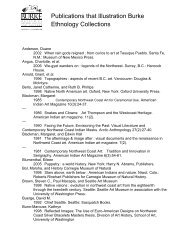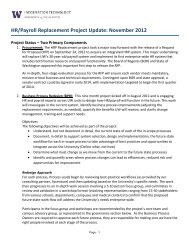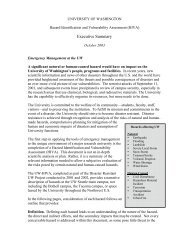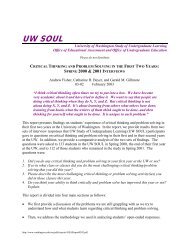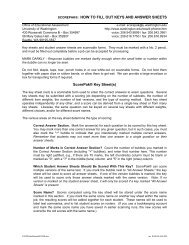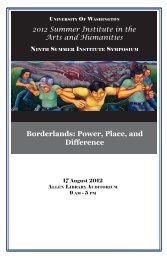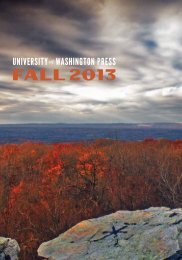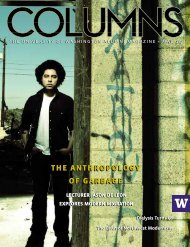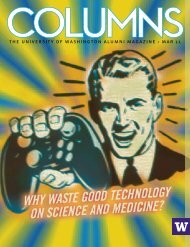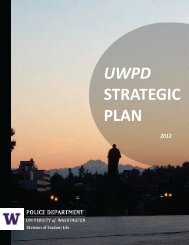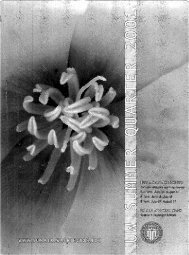PDF version - University of Washington
PDF version - University of Washington
PDF version - University of Washington
Create successful ePaper yourself
Turn your PDF publications into a flip-book with our unique Google optimized e-Paper software.
Face Time inquisitive and inventive<br />
BY JULIE GARNER<br />
A Patent Success<br />
Catching up with Robert Charlson,<br />
’64, pr<strong>of</strong>essor emeritus <strong>of</strong> Atmospheric<br />
Sciences and Chemistry, and coinventor<br />
<strong>of</strong> the first UW-held patent<br />
that brought royalties to the UW<br />
Standing on the deck <strong>of</strong> the ocean<br />
liner RMS Queen Elizabeth in 1965, Bob<br />
Charlson and his bride were taking a<br />
belated honeymoon trip after a year in<br />
England, where Charlson studied as<br />
a Fulbright Scholar. He couldn’t stop<br />
staring at the haze in the sky over<br />
the North Atlantic Ocean.<br />
“I asked myself over and over, ‘why<br />
is it so hazy way out here in the middle<br />
<strong>of</strong> the ocean? It should be clean!’ ” recalls<br />
Charlson, who got his doctoral degree in<br />
atmospheric sciences from the UW. Little<br />
did he know that question would drive<br />
his research for the next 45 years.<br />
Charlson is known worldwide among<br />
atmospheric scientists for his research<br />
into haze, or aerosols, the term used for<br />
the small particles in the atmosphere<br />
that affect climate and worsen lung conditions<br />
because they contain toxic and<br />
irritating pollutants like sulfuric acid.<br />
When global warming research<br />
intensified 30 years or so ago, Charlson’s<br />
work began to be appreciated. To measure<br />
aerosols and their effect on climate,<br />
he invented an instrument called the<br />
integrating nephelometer (left). It was the<br />
first UW patent to generate royalties.<br />
He started thinking about inventing<br />
as an undergraduate at Stanford.<br />
“One <strong>of</strong> my jobs was to fetch liquid<br />
nitrogen from a big tank in the physics<br />
department. To get there, I had<br />
to walk past all <strong>of</strong> these glass cases<br />
holding prototypes <strong>of</strong> the inventions<br />
<strong>of</strong> the klystron tube (think radar and<br />
microwave ovens) with little handwritten<br />
cards explaining them. I began to<br />
think about invention and to see myself<br />
as someone who could develop ideas.”<br />
Today, the UW processes about 200<br />
patent applications every year. Charlson<br />
would like to create a place on campus to<br />
showcase the many inventions that have<br />
come out <strong>of</strong> the UW, such as the shunt<br />
that made kidney dialysis available to<br />
the masses; the groundbreaking work on<br />
protein expression in yeast that led to a<br />
Hepatitis B vaccine; and dozens more.<br />
“Man-made haze has helped cool<br />
the planet but it won’t solve global<br />
warming,” says Charlson, “considering<br />
that there are over 600 coal-fired power<br />
plants operating to this day in the U.S.<br />
In China, they are opening a new coal<br />
power plant every week or so.” Burning<br />
coal is the largest single source <strong>of</strong> carbon<br />
dioxide, which is a so-called “longlived<br />
greenhouse gas.”<br />
One delicious result <strong>of</strong> UW research<br />
is that we can eat plump, succulent oysters<br />
in the summer. UW researchers introduced<br />
a condition called polyploidy, which<br />
means that farmed oysters no longer need<br />
to have a specific spawning season. ■<br />
—Julie Garner, ’10, is a Columns staff writer<br />
Learn how UW is helping researchers commercialize<br />
innovations: www.uwc4c.com<br />
RON WURZER<br />
12 UW 150 Years



